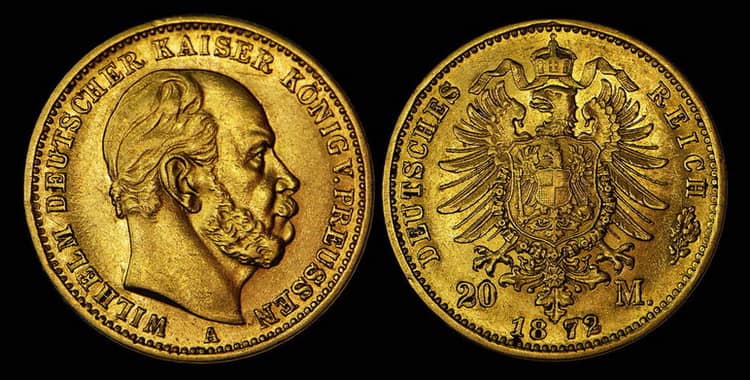
20 marks (Germany) is a series of gold coins of 1871-1918. The new monetary unit has replaced the centuries-old silver thalers of Germany and Austria. Its appearance played a significant role in uniting disparate states and creating a single monetary system. Own currency led to the rapid socio-economic growth of the country and the level with the United States.
History
Until 1871, Germany consisted of 35 monarchical states and 4 free cities with a predominantly German population. Each settlement had sovereignty and had the right to mint its own currency. Totally at that time there were 140 names of monetary units, 76% of them were coins. This variety brought a number of difficulties, especially the constant need to exchange your own currency for the next when moving from one city to another.
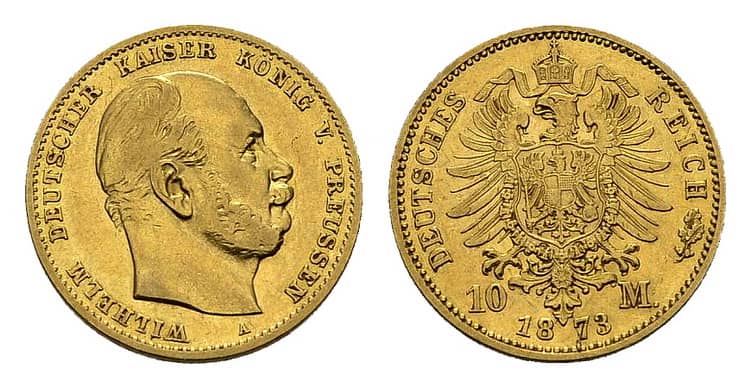
The introduction of a single monetary system would help solve this and other problems in isolated areas of Germany. First of all, the new currency removed the need to pay customs duties, and also accelerated economic growth. To solve this problem, in 1854, an agreement was signed between the German states on the creation of a common monetary system, and on December 4, 1871, a single monetary system appeared in Germany. As the national currency the gold mark was chosen.
1 mark was equal to 0.358423 grams of pure gold (100 pfennings). According to the regulations, the issue included the mintage of 10 and 20 German marks from precious metal. The law prescribed a single weight, design and composition. The former coins were to be exchanged for new ones – the Allied thaler was 3 marks, 1 guilder – 1.57 marks or one mark and 57 pfennigs. Gold 900 samples were minted coins of large denomination, 900 silver samples – changeable 1, 2 and 5 marks. Germany became the third country after England and Portugal, which joined the gold standard.
Did you know? In 1871, Wilhelm I was appointed the ruler of the united Germany (Prussia), heir to one of the important German houses (the Hohenzollerns). After a brilliant victory during the Franco-Prussian war, he was crowned as emperor. After the death of the ruler in 1888, the throne passed to his son – Frederick III, who ruled only 99 days. Then the state was ruled by his son – Wilhelm II. He was the last of the Hohenzollern family, occupying the throne.
The activities of Wilhelm II was aimed at the arms race, which was partly the cause of the World War I. In 1914, the exchange of paper money and change coins for 20 and 10 gold marks was banned, and in 1915 the last coin of 20 marks of Germany was minted. In 1918, the monarchy as a form of government ceased to exist on the territory of the German Empire.
On 20 stamps of Germany, in turn, minted portraits of all three rulers:
- 1871-1888 – Wilhelm I;
- 1888 – Frederick III;
- 1888-1918 – Wilhelm II.
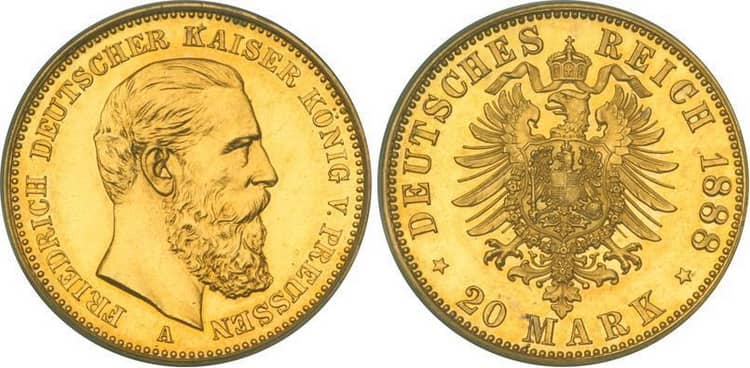
Thus, in 1888, three series of coins in denominations of 20 grades in gold were issued in Germany – with the portrait of Wilhelm I, Frederick III and Wilhelm II. Some copies were destroyed or sent to the smelter for minting coins with the image of a new ruler.
The First World War and its consequences had a negative impact on the development of Germany. The central bank had to simplify the gold standard. The paper brand has rapidly depreciated. Consumer prices increased 12 times. In 1923, the price of 20 grades of gold in Germany rose to 23 trillion paper marks.
Did you know? In the middle of the XIX century, when the thaler was the main currency in Germany, the salary of a good employee was 10 thalers per month. Workers got worse 7-8 coins, and laborers paid 5 coins. 1 thaler was 30 pennies. The cost of essential products was low. 1 kg of veal cost 6 Groschen, a kilogram of flour – 2.5 Groschen, and 1 kg of potato – ½ Groschen. In 1871 there was a change in the national currency. The main money were recognized brand and pfennig. In the prewar period, workers received 30 marks a month, and workers a level higher than 45 marks. At the same time, the prices of products did not grow, but decreased, the salary from 1871 to 1913. increased 1.50-2 times. A furnished room cost 50-60 marks per month, and a trip around Berlin – ½ mark.
Design
In 1871, the design of 20 brands was legalized, as well as the weight and composition of coins. According to the law, one of the parties must have the imperial national emblem, the year of coinage and denomination. On the other side there should be a portrait of the ruling monarch of the German state, a sign of the mint and an inscription describing the image.
The main characteristics of the gold coins of the German Empire
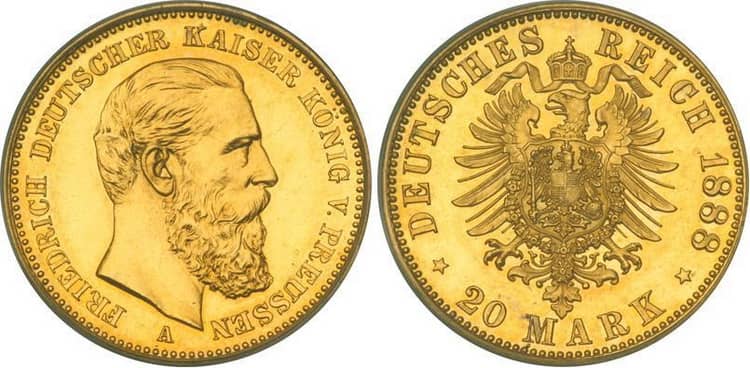
Total weight: 7.9650 grams.
Net weight: 7.1685 grams.
Sample: 900.
Diameter: 22.5 mm.
Years of coinage: 1872-1915
Total circulation: 231,000,000 copies.
Edge: patterned with the inscription “GOTT MIT UNS”.
According to the law on the stamping of gold marks, in 25 subjects of German lands, a portrait of the local ruler and the national emblem of free cities was allowed to be chased. For example, Duke Ernst Ludwig was minted on 20 marks of 1906 of the Duchy of Hesse (part of Germany), a portrait of Frederick I was present at the obverse of the Duchy of Anhalt, in Bavaria in 1874-1878. Obverse decorated Ludwig II, and in 1895, 1900, 1905 and 1913 – Otto I.
Did you know? In 1890, the gold standard determined the exchange rate of a particular country. The ratio of marks and monetary units of other countries for this period was: 1 pound sterling – 20.40 marks, 1 Portuguese real – 4.5 marks, 1 $ USD – 4.25 marks, 1 ruble in gold – 3.20 marks, 1 Austrian Guilder – 1.70 marks.
Characteristics of 20 grades of gold Wilhelm I
Obverse: on the front side there is a portrait of Kaiser Wilhelm I in profile. Face turned to the right. Under the image there is a sign of the Mint, and in the circle from left to right is the inscription “WILHELM DEUTSCCHER KAISER KONIG V. PREUSSEN”. The coin is decorated with a border and a side.
Reverse: On the reverse side, the symbol of the German empire is minted – a raven with divorced wings. On the chest of the bird is the national emblem of Germany, on the left paw the figure is 20, on the right is the letter “M”. Below is the date of the coinage. To the left of the crow along the wing is the inscription “DEUTSCES”, to the right – “REICH”, then an image of an oak leaf.
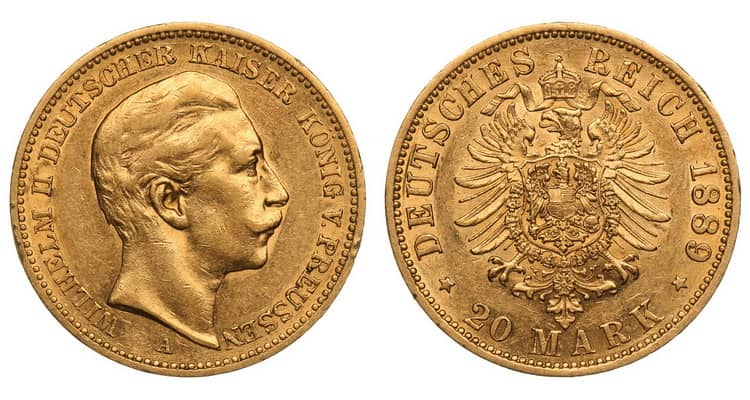
Circulation
It is known that from 1871 to 1918 at least 250 million gold coins of 10 and 20 marks were minted, but by the order of the Kaisers, almost the entire circulation was destroyed and smelted for minting new series. In 1939, in Hitler’s Germany, it was impossible to buy 20 marks – all the remaining copies were melted down for the needs of the country.
The circulation of 20 marks of Wilhelm II in the first 10 years of rule was colossal:
- 1890 – 3,694,754 pieces;
- 1891 – 2,752,457 pieces;
- 1892 – 1,814,842 pieces;
- 1893 – 3,171,741 pieces;
- 1894 – 5,814 982 pieces;
- 1895 – 4,134,809 pieces;
- 1896 – 4,238,568 pieces;
- 1897 – 5,393,628 pieces;
- 1898 – 6,542 219 pieces;
- 1899 – 5,873,229 pieces;
- 1900 – 5 162 616 pieces.
The smallest circulation of 20 gold marks was released in 1906 and amounted to only 81,686 copies.
Cost of coins
The price of 20 marks depends on the year of minting, the degree of preservation. At the present time, coins have practically no numismatic value. Therefore, their cost is on average $ USD 500. There are samples, whose price comes to $ USD 1200. Such coins have a high degree of preservation.
Comments
No commens yet.